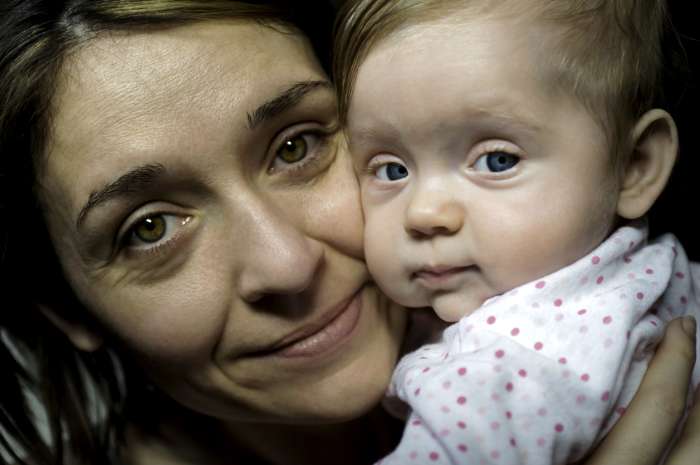If you are expecting a little one, you are probably wondering what your newborn baby will look like. What features will they inherit from Mom and Dad?
One big question you might have is what eye color will your baby have? Science can go some way to predicting this but the genetics of eye color is a lot more complicated than you might think.
Related: Will My Baby’s Eyes Change Color? A Genetic Explanation
What Do We Mean By Eye Color?
When we talk about someone’s eye color we are referring to the colored part of the eye called the iris. Its function is to change size to control how much light enters the eye through the hole in the center (the pupil).
Iris color exists in a continuum of different shades from light blue to dark brown and is determined by the amount of a colored pigment called melanin in the front layers of the iris. Melanin is a dark-colored pigment produced by different cells throughout the body and also determines skin color.
Is Personality Genetic? Understanding Inherited Personality Traits
You joke you’re “type A” and your child’s other biological parent is lazy and carefree. Does that mean your child will be like you - organized and detail-oriented - or your partner? Parents have always wondered how their little ones end up with certain personalities. Turns out that science has some answers. What’s the truth behind the genetic transfer of personality traits? Read More
People with brown eyes have a lot of melanin in the iris. As the amount of melanin decreases, the color changes from brown to hazel eyes, then green eyes and finally blue.
It makes sense that irises with a lot of melanin are dark brown, but what is a little confusing is how having less melanin results in blue eyes. Blue eyes don’t contain a blue pigment. Instead, blue eye color has to do with how eyes reflect light.
Irises with a small amount of melanin will scatter the light and only the long wavelengths, which are blue in color, are reflected. This is exactly the same mechanism behind what makes the sky appear blue!
People with gray eyes have low levels of melanin in the iris, just like blue eyes, but a higher-than-normal amount of collagen makes these eyes appear gray.
Related: Will My Baby’s Eyes Change Color?
Globally, brown is the most common eye color, and this is the case in the US as well. According to a survey carried out in 2014 of 2000 Americans by the American Academy of Ophthalmology 45% of people in the US have brown eyes, while only 9% have green eyes.
Our eyes may now have a rainbow of different colors but it hasn’t always been this way. Scientists believe that until around 10 000 years ago, humans only had brown eyes. They believe the variations in eye color we see today were caused by a single mutation in a gene.
How Is Eye Color Determined?

As with many human physical traits, eye color is determined by our genes. Genes are arranged in long strings of DNA called chromosomes. Most of your cells contain 46 chromosomes organized in 23 pairs. You inherit one chromosome in each pair from each parent so it stands to reason that a child’s eye color is linked to their parent’s eye colors.
In high school, you may have been taught a very simple explanation of how eye color is inherited. Scientists in the early 20th century developed the theory that eye color was determined by a single gene that had two versions, or alleles: a blue allele and a brown allele.
The brown allele was thought to be dominant over the recessive blue allele. This simplistic theory tells us that if a baby’s eye color is blue then they have two blue alleles, one inherited from each parent. If a baby’s eye color is brown, they either have one brown and one blue allele (because brown is dominant over blue), or two brown alleles.
This theory was accepted because it explained certain phenomena; two brown-eyed parents normally have children with brown eyes, and two blue-eyed parents normally have children with blue eyes. However, it can’t explain everything.
Can Two Blue-Eyed Parents Have a Child with Brown Eyes?
Even though it is rare, two blue-eyed parents can have a brown-eyed child. We also know that there are many more eye colors than simply brown and blue. Eye color is as specific to an individual as a thumbprint – your eye color is truly unique.
More recent studies have found that the inheritance of eye color is much more complicated. Rather than being controlled by a single gene, we now know multiple genes are involved, meaning that eye color is a polygenic trait (poly means many).
A particular region on chromosome 15 contains two genes that are involved in melanin production, and therefore eye color: OCA2 and HERC2. OCA2 provides instructions for producing the P protein located in the melanocytes (specialized cells in the iris that produce melanin).
If more protein is produced, the eyes make more melanin and are browner in color. The opposite is true - when less protein is produced, the eyes make less melanin and the eyes are bluer. The HERC2 also plays a role as it codes for a protein that controls the activity of the OCA2 gene.
In March 2021, a team of researchers at King’s College, London looked at the eye color of 195,000 people and determined there are dozens of genes that contribute to eye color including ASIP, IRF4, SLC24A4, SLC24A5, SLC45A2, TPCN2, TYR, and TYRP1 to name a few.
Variations in these genes, plus complicated interactions between them, also influence eye color.
Can We Predict Eye Color?

Although you can’t predict for certain what a baby’s eye color will be, you can make an educated guess based on the parent’s eye colors. Let’s see what combinations are possible.
Two brown-eyed parents
This combination is almost certainly going to produce a brown-eyed child, and the odds increase even higher if the parents have an Asian, African, or Hispanic background.
Two blue-eyed parents
The same pattern is seen in this scenario. Baby will most likely have a blue eye color like Mom and Dad, especially if they are both caucasian.
One brown-eyed parent and one blue-eyed parent
This is a little trickier to predict. If the brown-eyed parent has an Asian, African, or Hispanic background that the odds are tipped slightly more toward a brown-eyed baby. However, blue eyes are not to be ruled out, especially if a grandparent is blue-eyed.
What Else Can Affect Eye Color?
Genetic variations or random mutations in the genes sometimes produce unexpected results in eye color. Examples include:
- Heterochromia: A condition that causes a person to have two different shades of irises or multiple colors in a single iris.
- Albinism: A condition where the eyes, skin, or hair have little or no color due to a reduced amount of melanin, or none at all. People with albinism can have very pale blue eyes or violet eyes. The violet color is caused by light reflecting off the blood vessels in the back of the eye.
- Aniridia: The complete or partial absence of the iris. In people with this condition, you’ll see little or no eye color and instead a large sometimes misshapen pupil.
Eye Color Isn’t Just Determined By Our Genes
One prominent scientific study showed that eye color has a strong genetic influence, but this is not the only factor in play when it comes to natural eye color. (Zhu et al, 2004)
The researchers studied the eye color of twins and found that 74% of the variation in their eye color was due to differences in a single gene (OCA2), 18% due to other genes, and 8% because of environmental factors.
People with lighter eye colors might see them lighten further as melanin degrades, resulting in less color. Irises also might get darker due to sun exposure, which results in higher melanin production in the iris.
Some illnesses, like Waardenburg syndrome, Pigmentary glaucoma, and Fuch’,s heterochromatic uveitis might also produce a change in eye color.
On some occasions, it might seem like your eyes have changed color when in reality they haven’t. This includes the color of clothing you are wearing, or pupil changes (a large pupil can make your eyes look darker).
If you ever met someone with an eye color that seems too good to be true like stunning dark blue eyes, or a bright emerald green then it might be because it is! It is possible to give ourselves a temporary change in eye color by using colored contact lenses.
Do Babies’ Eyes Change Color?
Your blue-eyed newborn baby may not be so blue-eyed on their first birthday. Eyes can change color with age. More melanin is produced over time, causing the newborn eye color to darken. This is more noticeable if your baby has light eyes at birth. Eyes usually reach their final shade somewhere around six months of age but it could change throughout the first year of life.
If science has taught us anything it’s that predicting the color of your baby’s eyes before it is born is not an easy task. The combination of many different genes that influence eye color, plus random mutations can end up giving us very surprising results!
Also, it is worth remembering that eye color at birth is not always fixed, your baby may surprise you once again with a change in eye color as they get older.



